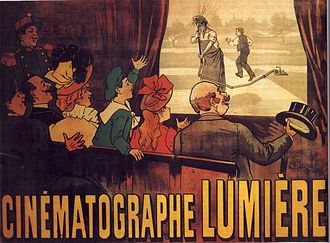 Two of this week’s milestones in the history of technology reflect the analog-to-digital transformation of film making and distribution.
Two of this week’s milestones in the history of technology reflect the analog-to-digital transformation of film making and distribution.
On December 28, 1895, the first public screening of films at which admission was charged was held by the Lumière brothers at the Salon Indien du Grand Café in Paris. It featured ten short films, including their first film, Sortie des Usines Lumière à Lyon (Workers Leaving the Lumière Factory). Each film was 17 meters long, which, when hand cranked through a projector, ran approximately 50 seconds.
British photographer Eadweard Muybridge invented the first movie projector, the Zoopraxiscope, in 1879. On October 17, 1888, Thomas Edison filed a patent for the first movie projector, the “Optical Phonograph,” which projected images just 1/32-inch across. In his patent application, he wrote: “I am experimenting upon an instrument which does for the Eye what the phonograph does for the Ear.”
On May 9, 1893, Edison presented the Kinetoscope, the first film-viewing device, at the Brooklyn Institute of Arts and Sciences. The first film publicly shown on the system was Blacksmith Scene, the earliest known example of actors performing a role in a film.
By 1900, the Lumière brothers had produced 1,299 short movies. For the World Fair that year, they developed their new Lumière Wide format which, at 75mm wide, has held the record for over 100 years as the widest film format.
35mm film was the standard for making movies and distributing them for about a century. On June 18, 1999, Texas Instruments’ DLP Cinema projector technology was publicly demonstrated on two screens in Los Angeles and New York for the release of Lucasfilm’s Star Wars Episode I: The Phantom Menace. By December 2000, there were 15 digital cinema screens in the United States and Canada, 11 in Western Europe, 4 in Asia, and 1 in South America. By the end of 2016, almost all of the world’s cinema screen were digital.
The digital transformation of movie theaters also attracted new types of content. On December 30, 2006, a live HD broadcast from the Metropolitan Opera was transmitted for the first time to 100 movie theaters across North America plus others in Britain, Japan and one in Norway. Today, Live in HD transmissions are seen on more than 2,000 screens in 70 countries around the world.
The live broadcasts from the Metropolitan have been followed by similar ones from the Royal Opera House, Sydney Opera House, English National Opera and other opera, ballet and theater companies such as NT Live, Branagh Live, Royal Shakespeare Company, Shakespeare’s Globe, the Royal Ballet, Mariinsky Ballet, the Bolshoi Ballet and the Berlin Philharmoniker.
The range of offerings has expanded to include variety of music concerts, live sport events, documentaries and lectures, faith broadcasts, stand-up comedy, museum and gallery exhibitions, and TV specials such as the record-breaking Doctor Who fiftieth anniversary special The Day of The Doctor.
Opera, theater, ballet, sport, exhibitions, TV specials and documentaries are now established forms of what became to be known as “Event Cinema.” It is estimated that worldwide revenues of the Event Cinema industry will reach $1 billion by 2019.

